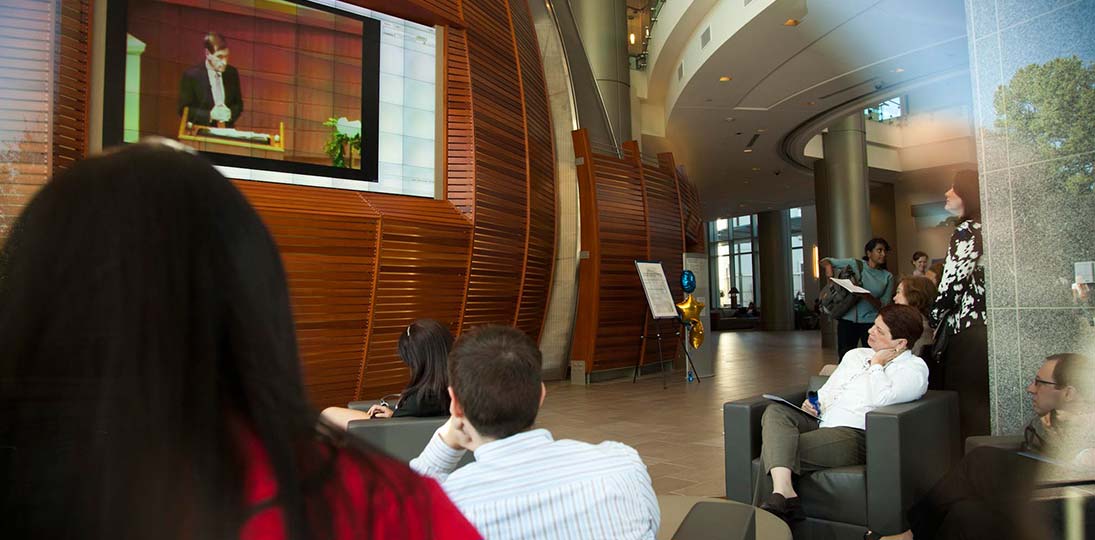We’ve talked about where to put your digital signs, and some things you might consider when placing digital signage displays. One of the most eye-catching display options you can choose is a digital sign video wall.
Sometimes, you’ll hear a very large screen referred to as a video wall, but for this post, we’re sticking to the more common setup that consists of multiple monitors tiled together to form one large display area.
For digital sign video walls, we usually have screens with very thin bezels next to each other so there’s no perceivable gap between the displays. In basic terms, you’re building a jumbo display out of smaller screens.
Why digital signage video walls are cool
Using a video wall can really differentiate your digital signage. As we always preach, the purpose of digital signage is to engage your audience and convey relevant messages. The more attention you can draw to your messages, the more effective they’ll be.
Video walls are, by nature, prominent and eye-catching. They really draw attention and are usually placed in high traffic areas, like a lobby or student union, to reach a wider audience. And, let’s face it…they just look cool.
With the evolution of digital signage hardware, we’re able to do some really creative things with video wall arrangements. You don’t have to stick to squares anymore. Even though the most popular setup is still a large rectangle, your video wall can be as complex and creative as you want.
Technical considerations for your digital signage video walls
If you’re using Visix software to power your video wall, you’ll need:
- Various displays to make up the video wall
- Visix media player
- Signal processing and distribution options:
- Video cards
- Scalers and processors
- Connected displays
When integrating AxisTV with a video wall, the media player can simply be thought of as the PC that supplies the source video signal. However, a media player by itself usually won’t be able to cover the giant resolution you’ll need to cover all of the screens as a whole – additional hardware and external graphics cards may be required.
Less complex video walls can be driven from multi-output video cards. Each display receives its own video signal, and for best quality, each screen should receive a video signal that matches its native resolution. Ideally, each screen in the wall will have the same native resolution.
More complex video wall arrangements can require specialized video processors that are specifically designed to manage and drive large video walls. Sometimes, the media player will be only one of many video sources for the video wall processor. This provides lots of flexibility, but can be more expensive.
Some display manufacturers design displays that can be daisy-chained to create smaller video walls, like a simple 2×2 screen configuration. Usually, each display receives the entire video signal and scales only a portion of it to fill the screen. The downside is that this can compromise the image quality because you’re limited by the single output resolution.
Design considerations for digital signage video walls
Your video wall will need special attention – don’t just treat it as another endpoint. This is your centerpiece – so be creative and have fun.
If the video wall is being used in conjunction with other digital signage in your facility, your standard layout designs may not work well on the wall. You’ll need a separate plan for your video wall layout. First, work out the relationship between the logical orientation of content for your viewers and the physical orientation of the individual monitors:
- Do you want one image stretched over all of the screens?
- Do you want different images on each screen?
- Would it be more creative to mix and match with some single screens and some stretched?
- Which playlists are most important and need to be placed more prominently?
You also need to consider bezel size and placement, and the arrangement of the displays. The last thing you want is a big impressive video wall with a line running through a face or some important text. And, remember to design with size in mind. You don’t want low-res images or stretched/squished content to ruin your star attraction.
As always, the environment makes a big difference, so you’ll need to design your layout based on your audience. If your viewers are passing by the screen quickly, then simple, bold messages with minimal text will have the most impact. If the video wall is in an area where people hang out for a while (waiting room, reception area, etc.), then you can deliver more detailed, varied content to your audience.
